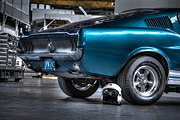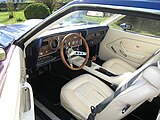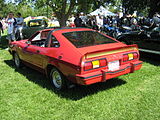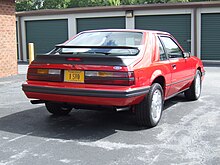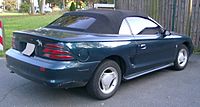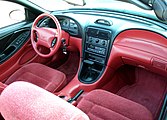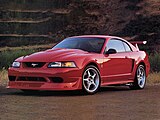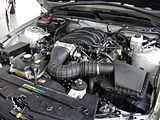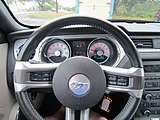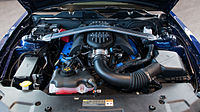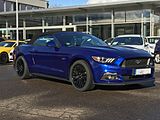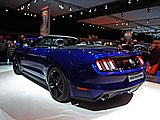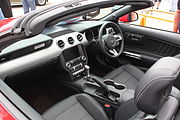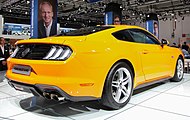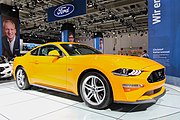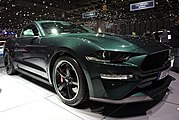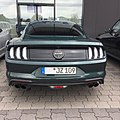Ford Mustang
| Ford Mustang | |
|---|---|
| Production period: | since 1964 |
| Class : | Sports car |
| Body versions : | Coupé , station wagon coupé , convertible |
The Ford Mustang is a sports car built by the American car manufacturer Ford since spring 1964 and the forerunner of the pony car class. The name “Mustang” goes back to a suggestion by head stylist John Najjar, who found the US Air Force's “ North American P-51 ”, code-named “ Mustang ”, outstanding. Since the name “Mustang” was trademarked for the companies Krupp and Kreidler , the Mustang was marketed in Germany as “T5” until 1979. The Mustang replaced the Thunderbird as Ford's number one sports coupé.
In August 2018, the 10 millionth Ford Mustang was produced in Dearborn , Michigan .
Mustang I (1964–1973)
| Mustang I (1st generation) | |
|---|---|
|
Ford Mustang, 1964 |
|
| Production period: | 1964-1966 |
| Body versions : | Coupé , convertible |
| Engines: |
Petrol engines : 2.8-4.7 liters (74-199 kW) |
| Length: | 4613 mm |
| Width: | 1735 mm |
| Height: | 1344 mm |
| Wheelbase : | 2700 mm |
| Empty weight : | 1109-1200 kg |
On April 17, 1964, Ford presented the first-generation Mustang on the technical basis of the Ford Falcon as a coupé and as a convertible, creating the class of pony cars that was later named after him .
The Mustang was a great success right from the start. The vehicle was intended to appeal to the young, sporty public and could be purchased from US $ 2,368 (based on today's purchasing power and adjusted for inflation, this corresponds to around US $ 19,000). On the evening of the official start of sales, April 17, 1964, around 22,000 vehicles had already been sold. By the end of the first (albeit excessively long) model year, 680,992 units had been sold. This was a record in the United States. Obviously, it filled a void in the market the extent of which was impossible to guess. Ford was optimistic that 240,000 copies would be sold. Neither the conceptually similar Chevrolet Corvair Monza , built from 1960, nor the Plymouth Barracuda , which appeared shortly before the Mustang, were even remotely as successful.
The success of the Mustang was based not only on an elaborate and cleverly designed advertising campaign before and during the market launch, but also on an extensive list of individual extras and equipment packages. Every customer should be able to design their Mustang model according to their individual taste, whether as a sparsely equipped six-cylinder model, as a small luxury coupé or as a sports device with a powerful V8 engine .
First version
The early Mustang models produced before September 1964 are also officially assigned to the 1965 model year. Among other things, they had a slightly smaller radiator grille and the 4.3-liter V8 engine (260 cubic inches ) from the Ford Falcon, instead of the 4.7-liter V8 engine (289 cubic inches) used from September. In order to distinguish these first vehicles from those built from September onwards, they are usually unofficially referred to as "model year 1964 ½".
Model year 1964 ½
The first Ford Mustang were white convertibles with red interiors that rolled off the assembly line in Dearborn on March 9, 1964. They were brought to the North American public through an extensive advertising campaign. Even before the official presentation, television commercials under the motto The Unexpected had run. On April 17, 1964, the Mustang was shown for the first time as part of the New York World's Fair , and from April 19, all three national television channels ran new TV spots in which the car could also be seen, unlike the previous spots.
From 1964 to 1979 the Ford Mustang was offered as the Ford T5 in Germany. The price for the 3.3-liter version with hardtop in 1966 was DM 16,100. Based on today's purchasing power and adjusted for inflation, this corresponds to around EUR 34,000.
Model year 1965
A 3.3-liter in- line six-cylinder replaced the 2.8-liter engine. The Fastback , a hatchback coupé, as well as disc brakes on the front axle and the GT package, etc. were new to the program . a. with side stripes on the sills. The 4.7-liter V8 engine was now also available in weaker versions with 147 kW (200 hp) or 165 kW (225 hp).
Model year 1966
The 1966 model was externally recognizable by the Mustang emblem on the radiator grille, which was no longer “supported” by vertical chrome bars; also on the three chrome inserts on each of the air scoop dummies in front of the rear wheel arches. The safety equipment was supplemented by seat belts at the front and rear, a padded dashboard and hazard warning lights. The speedometer with a horizontal scale used in the first model year was replaced by round instruments.
1.1 million units of the original Mustang were produced in two and a half years, including 864,000 Hard Top Coupés, 105,000 Fastbacks and 145,000 Cabriolets.
Shelby Mustang 1965/66
The tuning company Shelby American , founded among others by Carroll Shelby , an ex-racing driver who already had contacts with Ford through the development of the Shelby Cobra , built tuning vehicles based on the Ford Mustang from 1965, some of which were intended for racing, but mostly when Mustang high-performance versions were intended for private customers.
In 1965 in Venice (Los Angeles) 562 copies of the Shelby GT-350 , a high-performance version of the Mustang Fastback with 225 kW (306 PS) strong 4.7-liter V8 engine, including 36 GT-350R, were made exclusively for racing were designed. In 1966 Shelby produced 1438 GT-350 Fastback Coupés and six GT-350 Cabriolets with unchanged technology. In addition there were 936 copies of the GT-350H, a mostly black with gold-colored decorative stripes, not for sale special series for the car rental company Hertz . The outside of the Fastback versions differed from the previous year's models by the plexiglass inserts in the C-pillars . In 2006/2007, based on the current Mustang, a new edition of the Hertz version was created, which in turn was sold exclusively to the car rental company.
In contrast to products from other tuners, Shelby Mustangs were also sold directly through the Ford dealer network.
Second version: model years 1967–1968
| Mustang I (2nd generation) | |
|---|---|
|
Ford Mustang, 1968 |
|
| Production period: | 1967-1968 |
| Body versions : | Coupé , convertible |
| Engines: |
Gasoline engines : 3.3–7.0 liters (85–246 kW) |
| Length: | 4663 mm |
| Width: | 1801 mm |
| Height: | 1311 mm |
| Wheelbase : | 2744 mm |
| Empty weight : | 1168-1244 kg |
Model year 1967
A new Mustang was presented for the 1967 model year, which looked similar to the previous model, but was slightly larger in all dimensions, also to make room for larger-displacement machines in the engine compartment. The radiator grille was slightly larger than before, as were the dummy air scoops in front of the rear wheels and the rear panel, in the middle of which the tank cap was located, was concave . The engine range has been expanded to include the new 6.4-liter engine (390 cubic inches) with 235 kW (320 hp).
Model year 1968
In these models, Ford dispensed with decorative beads directly in front of the side hood dummies in front of the rear wheels. The engine range has been thoroughly revised; of the 4.7-liter V8 engine, only a 143 kW (195 hp) variant with twin carburettors remained available, the 6.4-liter V8 engine was available in a normal version with 206 kW (280 hp) and a GT -Variant with 239 kW (325 PS). New were a 4.9-liter V8 engine with 169 kW (230 hp) and two different seven-liter engines. It was once the Cobra Jet-V8 (7015 cm³) with 246 kW (335 PS), on the other hand to the structurally unrelated high-performance seven-liter engine with 6999 cm³ and 287 kW (390 PS).
The second-generation Mustang produced 789,000 copies in two years, including 113,000 fastback models and 70,000 convertibles.
Shelby Mustang, 1967-1968
Unlike the forerunners, the second generation Shelby Mustang were no longer designed for racing, but for civilian use.
The models from 1967 differed more visually from the series Mustang; The Mustang's grill insert had been replaced by two centrally seated round auxiliary headlights, and there were locking pins and air intakes on the bonnet. Air scoops were also found in front of the rear wheels and on the now windowless C-pillars, and the rear lights of the regular Mustang gave way to wider units like the Mercury Cougar . 1175 units of the GT350 with the well-known 225 kW (306 hp) 4.7-liter engine and 2050 units of the Shelby GT500 with a tuned Cobra-Jet 7-liter V8 that developed it to 246 kW (355 hp) were produced ) brought. These models were only available as fastback coupés.
In 1968 the Shelby models were given a separate front section with a larger radiator grille, additional headlights and scoops on the front edge of the bonnet. The Cougar rear lights were replaced by those from the 1965 Ford Thunderbird. The range now included fastback and convertible models (with a standard roll bar) in the versions GT350 (with either the 250 kW (340 hp) or 239 kW (325 hp) 4.9-liter V8 engine), GT500 (with a 265 kW (360 PS) Cobra-Jet 7-liter V8 or the high-performance 7-liter V8 with 294 kW (400 PS)) and GT500KR (with a Cobra-Jet engine that also produces 294 kW (400 PS) V8). The numbers were: GT350 Fastback: 1253; GT350 Cabriolet: 404; GT500 Fastback: 1140; GT500 Cabriolet: 402; GT500KR Fastback: 933 and GT500KR Cabriolet: 318 pieces, a total of 4450.
Due to the high demand for replicas of the “Eleanor” called Shelby GT500 from the movie Just 60 seconds left (see below), the American company Unique Performance decided to build this model on the basis of used Ford Mustang Fastbacks in small series. This project was personally supported by Carroll Shelby and so these models are officially called Shelby GT500E (E for Eleanor). The base model developed 239 kW (325 hp) and cost $ 119,000. Production ended in 2007 after irregularities in the vehicle identification numbers became known, stagnant production and ultimately economic problems on the part of Unique Performance .
Third version: model years 1969–1970
| Mustang I (3rd generation) | |
|---|---|
|
Ford Mustang, 1969 |
|
| Production period: | 1969-1970 |
| Body versions : | Coupé , convertible |
| Engines: |
Petrol engines : 3.3–7.0 liters (85–276 kW) |
| Length: | 4760 mm |
| Width: | 1824 mm |
| Height: | |
| Wheelbase : | 2700 mm |
| Empty weight : | 1219-1462 kg |
Model year 1969
The third generation Mustang was again a bit longer and wider. The design stuck to the previous canon, but was revised in some points. The 1969 model received twin headlights; the outer headlights sat in deep cavities in the fender tips, the inner (high beam) headlights in the radiator grille. The hoods in front of the rear wheels now pointed backwards. In the hatchback coupé, known as the “Sportsroof” from 1969, these indicated air inlets in front of the rear wheels were completely omitted. For this purpose, the 1969 Sportsroof had air inlets on the fender flanks at the level of the door handles. These ceased to exist with the boss and then completely from 1970.
New to the program was the Mustang Grandé , a luxury version of the notchback coupé with a standard vinyl roof , wood foil on the dashboard and other equipment details . Also new was the Mustang Mach I (only available as Sportsroof) as a sports version of the Fastback with a 5.8-, 6.4- or seven-liter V8 engine. It was characterized by the GT equipment, a de-luxe interior with sports seats, high-quality floor carpets, a dashboard with imitation wood equipment and a large clock on the passenger side, a matt black bonnet and a scoop.
The Mustang Boss 302 was derived from the racing version of the Trans-Am series with a high-performance five-liter V8 engine, which was also available as the Boss 429 with another seven-liter V8 engine (7031 cm³ or 429 cubic inches ). The capacity limit in the Trans-Am series, however, was five liters.
Model year 1970
The 1970 models received a slight facelift; they now had only two headlights again, which were located within the wider grille instead of the high beams in the 1969 model year. There were grill-like, two-part inserts in the fender tips. The rear panel was no longer concave, but flat. These changes arguably were a tribute to the muscle car era. Mustang Boss, Mach I and Grandé remained on offer. The 6.4 liter engine was omitted. In addition, the air inlets on the flanks of the sports roof were omitted.
Ford produced almost 497,000 units of the third generation Mustang in two years, including 35,700 Grandé, 113,400 Mach I and around 10,000 Boss.
Shelby Mustang, 1969-1970
Shelby took over the body of the current Mustang, but again significantly modified the front and rear. The GT-350 was offered as a Sportsroof (1085 units) and Cabriolet (194 units) with a 213 kW 5.8-liter V8 engine and the GT-500 also as Sportsroof (1536 units) and Cabriolet (335 units) , driven by a 246 kW Cobra-Jet seven-liter engine. The total number of pieces was 3150 copies.
For the 1970 model year, Shelby used up its existing parts supplies; the models did not differ from the previous year's versions. Another 315 GT-350 and 286 GT-500 were built. After that, the Shelby Mustang was discontinued.
Fourth version: model years 1971–1973
| Mustang I (4th generation) | |
|---|---|
|
Ford Mustang, 1971 |
|
| Production period: | 1970-1973 |
| Body versions : | Coupé , convertible |
| Engines: |
Petrol engines : 4.1–7.0 liters (65–276 kW) |
| Length: | 4801 mm |
| Width: | 1905 mm |
| Height: | |
| Wheelbase : | 2800 mm |
| Empty weight : | 1236-1486 kg |
Model year 1971
With the 1971 model year, the Mustang once again grew strongly in all dimensions, which was criticized from various sides. The fourth generation of models did not match the numbers of earlier models, but these stabilized at a low level. The bodies were more massive, while the glass surfaces became smaller. A notchback coupé in basic and grandé version, a hatchback coupé (called by Ford SportsRoof) in the basic version as well as Boss and Mach I as well as a convertible were also offered. This generation became known through the film " James Bond 007 - Diamond Fever ".
In terms of engines, a 4.1-liter in-line six-cylinder replaced the previous 3.3-liter version as the basic engine, the output of the 4.9-liter engine fell to 154 kW (210 hp), the 5.8- The liter engine was available with 176 kW (240 PS) or 210 kW (285 PS), the Cobra-Jet seven-liter engine came up with 272 kW (370 PS) or 276 kW (375 PS). The earlier Boss 302 and Boss 429 were replaced by the Boss 351 , in which the 5.8 liter engine developed 243 kW (330 hp).
Model year 1972
The Boss 351 was discontinued in 1972 , as were the seven-liter engines. The Mustang Mach I was now also available with the six-cylinder. From this model year onwards, the performance data were given in SAE net horsepower .
Model year 1973
Only details were changed for the 1973 model year, so the design of the radiator grille was changed. The 5.8 liter engine was only available in two power levels. The convertible of this year remained the last open Mustang until 1982.
420,000 copies of the fourth generation Mustang were built in three years, including 1,800 Boss 351s, 24,300 convertibles and 60,700 Grandé.
Motor data
| Parameters | 260 | 289 | 302 | 351 | 390 | 427 | 428 | 429 |
|---|---|---|---|---|---|---|---|---|
| design type | V8 petrol engine, installed lengthways | |||||||
| Valve control | OHV valve control, two valves per cylinder | |||||||
| cooling | Liquid cooling | |||||||
| Bore × stroke | 3,800 in × 2,870 in (96.52 mm × 72.898 mm) |
4,000 in × 2,870 in (101.6 mm × 72.898 mm) |
4,000 in × 3,000 in (101.6 mm × 76.2 mm) |
4,000 in × 3,500 in (101.6 mm × 88.9 mm) |
4.050 in × 3.784 in (102.87 mm × 96.1136 mm) |
4.236 in × 3.781 in (107.5944 mm × 96.0374 mm) |
4.130 in × 3.984 in (104.902 mm × 101.1936 mm) |
4,360 in × 3,590 in (110.744 mm × 91.186 mm) |
| Displacement | 260.4 in 3 (4267 cm 3 ) | 288.5 in 3 (4728 cm 3 ) | 301.6 in 3 (4942 cm 3 ) | 351.9 in 3 (5766 cm 3 ) | 390.0 in 3 (6391 cm 3 ) | 426.3 in 3 (6986 cm 3 ) | 427.0 in 3 (6997 cm 3 ) | 428.8 in 3 (7027 cm 3 ) |
| source | ||||||||
Mustang II (1973-1978)
| Mustang II | |
|---|---|
|
Ford Mustang Hatchback, 1974 |
|
| Production period: | 1973-1978 |
| Body versions : | Coupé , station wagon coupé |
| Engines: |
Gasoline engines : 2.3-4.9 liters (62-104 kW) |
| Length: | 4445 mm |
| Width: | 1783 mm |
| Height: | 1270-1278 mm |
| Wheelbase : | 2445 mm |
| Empty weight : | 1181-1304 kg |
Not least in response to criticism of the exaggerated size of the previous model, Ford launched the Mustang II based on the Ford Pinto in autumn 1973 as a notch and hatchback coupé with four and six-cylinder engines. A V8 unit was also offered later.
This Mustang was 35 centimeters shorter, twelve centimeters narrower and, depending on the version, around 50 to 150 kilograms lighter than the direct predecessor model. The notchback coupé was offered in a basic and a more luxurious Ghia version and the hatchback coupé in a basic and a sporty Mach I version. A 2.3-liter inline four-cylinder engine or a 2.8-liter V6 engine took over the drive.
Model year 1975
In 1975 a 4.9-liter V8 engine with 91 kW (124 hp) was added to the existing four- and six-cylinder units for an extra charge. The Ghia notchback received a modified roof line with a wider C-pillar . The other changes were in minimal details.
Model year 1976
Two equipment packages were new to the range. On the one hand the Stallion package, which was also available in a similar form for other Ford models, and which included a sports chassis , sports steel rims, sports exterior rear-view mirrors and a special silver / black paint finish; on the other hand, the Cobra II package, which was only available for the hatchback coupé.
The name brought back memories of the Shelby Cobra, but it was an equipment package with pure design elements such as a matt black radiator grille, massive spoilers, plastic louvre inserts over the rear side windows and trim strips on the sills and along the bonnet, the roof and the stern. The output of the V8 increased to 99 kW (134 hp).
Model year 1977
The Mustang II remained largely unchanged for this model year as well. The small engines lost a bit of power, the V8 increased to 104 kW (141 hp). In the course of the model year, a T-Roof with two removable glass roof halves was available for the hatchback coupé.
Model year 1978
Apart from new paint colors, there were no major changes. At the beginning of 1978, the Mustang King Cobra was added to the range as another sporty special model with a front spoiler apron, a rear spoiler, aluminum rims and rear fender flares.
Ford produced a total of 1.1 million units of the second Mustang in five years, including a good 89,000 Mach I.
Foxbody Mustang (1979-1993)
| Mustang III | |
|---|---|
|
Ford Mustang Coupé, 1979 |
|
| Production period: | 1979-1993 |
| Body versions : | Coupé , station wagon coupé , convertible |
| Engines: |
Petrol engines : 2.3-4.9 liters (64-171 kW) |
| Length: | 4549-4562 mm |
| Width: | 1735-1755 mm |
| Height: | 1316-1323 mm |
| Wheelbase : | 2550 mm |
| Empty weight : | 1101-1524 kg |
The third model generation of the Ford Mustang was based on the Fox platform from 1977, on which all RWD models that remained below the full-size platform , including the Ford Fairmont, were merged as part of the Group's downsizing efforts . As in the first generation, the Mustang was accompanied by a Mercury sister model, which was sold as the Mercury Capri , and thus essentially replaced the European Ford Capri , which was sold as an import model in the USA . The new Mustang was initially available as a two-door notchback and three-door hatchback coupe, which was followed by the convertible from model year 1983. The convertible conversion did not take place at Ford, but was taken over by the external partner C&C (Cars & Concepts) in Brighton (Michigan). In retrospect, the third generation is now usually divided into the model years 1979–1986 and 1987–1993 - the former are known as "Four Eyes" because of their distinctive four-way headlights. The platform name "Foxbody" is used almost universally today as a synonym for "Mustang".
The Mustang was introduced at a time when US manufacturers were exposed to considerable criticism in the aftermath of the oil crisis and at which US consumer confidence in the "big three" corporations had reached an all-time low. The sensational sales figures of the Foxbody were not only against the spirit of the times, but also forced competitor General Motors to revise its F and Y platforms, which have been more or less unchanged since the oil crisis, and to present them in their third and fourth generation in 1982 and 1983. The Foxbody Mustang also appeared at a time when the American accessories and performance industry, which had played an essential role in handling performance cars as late as 1970, was completely on the ground due to the catalytic converter requirement, the oil crisis and the CAFE regulations lay. As a result, a significant portion of the aftermarket focused on the first and only true new American performance car in nearly 10 years - making the Mustang an immensely popular drag racing platform (an honor that first and second generations were denied was).
Model year 1979
The new Mustang made its debut in the Basic and Ghia equipment levels, each powered by a 2.3-liter four-cylinder engine with 65 kW (89 hp), the 2.8-liter V6 engine with 82 kW (111 PS), which was replaced in the course of the year by a 3.3-liter straight-six, or a 104 kW (142 PS) five-liter V8 engine. The sporty Mustang Cobra with 2.3-liter turbo four-cylinder (104 kW) or V8, sports suspension, aluminum rims with Michelin TRX wide tires, Cobra decorative stickers on the bonnet and a matt black look was available for an additional charge of US $ 1173 compared to the basic model to have. Since the Mustang III acted as a pace car in the Indy 500 race , Ford launched a pace car replica in a limited special series.
Model year 1980
The shape of the front and rear spoilers on the Mustang Cobra was changed; the five-liter V8 engine was dropped in favor of a new 4.2-liter V8 engine with 89 kW (121 hp), the turbo four-cylinder now developed 112 kW (152 hp). For the notchback coupé, a vinyl roof was added to the range, which made the car look like a convertible with the roof folded up ("Carriage Roof").
Model year 1981
The automatic transmission was no longer offered in conjunction with the turbo four-cylinder engine.
Model year 1982
The model range was restructured, there were now the variants L, GL and GLX as well as the sporty top model instead of the Cobra the GT (only three-door) with a 117 kW (159 PS) five-liter V8 engine. The turbo four-cylinder disappeared temporarily from the offer.
Model year 1983
First slight facelift, front and rear have been gently revised. But above all, after a ten-year break, there was again a Mustang convertible, the GLX and GT. The five-liter high-output V8 now had 130 kW (177 hp), 3.3-liter six-cylinder engine and 4.2-liter V8 engine were eliminated, the turbo four-cylinder returned with injection and 106 kW ( 144 PS) back into the range, plus there was a new 3.8-liter V6 engine with 82 kW (112 PS).
Model year 1984
The Mustang SVO is being offered for the first time , a performance variant of the three-door model developed by the Ford Special Vehicles Operation department under the direction of Mike Kranefuss with a 130 kW (177 hp) 2.3-liter four-cylinder turbo engine, an extra sporty chassis and modified front section. This reaches a top of 215 km / h and accelerates to 100 km / h in 7.5 seconds, but above all the much lighter engine compared to the V8 makes the Mustang less top-heavy. The turbo engine without intercooler with 108 kW (147 hp) remained in the program. The model range was reorganized and included L, LX, GT and SVO. The five-liter engine was now offered as a carburettor version with 130 kW (177 hp) or with injection and slightly lower output (123 kW (167 hp)).
Model year 1985
The front and rear sections were slightly retouched, the entry-level L model was omitted, as was the turbo four-cylinder (except in the SVO). The output of the five-liter V8 engine rose to 135 kW (183 hp) as an injection engine or 157 kW (213 hp) with the Holley quadruple carburettor.
Model year 1986
There was only one version of the five-liter engine with sequential injection and 149 kW (203 hp). The SVO was fitted with headlights flush with the body and an engine that was also increased in output to 149 kW.
Model years 1987/1988
The Mustang underwent a major facelift with flush headlights and new front and rear aprons. The SVO and the 3.8 liter V6 engine were no longer offered. The GT received an eye-catching spoiler and sill package. The five-liter engine, standard in the GT and optional in the LX, now developed 168 kW (228 hp).
Model year 1989
The LX with the five-liter V8 engine, which is available at an additional cost, was now officially called the "LX 5.0L Sport". Central locking and power windows were standard equipment in the Cabriolet from now on.
Model year 1990
The equipment of all models was supplemented by a driver airbag and rear three-point seat belts. The LX 5.0 received the chassis and tires of the GT (but not its rocker panel and spoiler work). In 1990, a special series called the 7up edition was produced for the 25th anniversary . 4103 of these were sold exclusively as green convertibles with a white interior and soft top and exclusively as 5.0-liter HO-V8 engines with 168 kW, 261 of which were exported.
Model year 1991
The 2.3-liter four-cylinder engine now had 78 kW (106 hp) thanks to double ignition. The convertible top could be folded more compactly.
Model year 1992
Changes to the details of the body were used to refresh the look.
Model year 1993
The GT now rolled on 16-inch alloy wheels. New to the range was the Mustang Cobra special model, limited to just under 5,000 units, with a 171 kW (233 hp) five-liter V8 engine, five-speed gearbox, 17-inch alloy wheels and a special rear spoiler.
In the summer of 1993, production of the sixth generation Mustang ran out after a total of around 2.5 million units (including around 270,000 convertibles and a few thousand SVOs).
Mustang IV (1994-2004)
| Mustang IV | |
|---|---|
|
Ford Mustang, 2000 |
|
| Production period: | 1994-2004 |
| Body versions : | Coupé , convertible |
| Engines: |
Petrol engines : 3.8-5.7 liters (108-290 kW) |
| Length: | 4610-4653 mm |
| Width: | 1824-1857 mm |
| Height: | 1341-1354 mm |
| Wheelbase : | 2570 mm |
| Empty weight : | 1383-1715 kg |
In the spring of 1994, just in time for the Mustang's 30th birthday, Ford introduced a new generation of the sports car as a two-door coupé and convertible in the basic, GT and Cobra versions, with the entire convertible being assembled by the manufacturer again, unlike its predecessor.
The new generation of the Mustang was based on a modernized version called Fox-4 of the 1977 Fox platform and had a rigid rear axle. The base model was powered by a 3.8-liter V6 engine with 108 kW (147 hp), the GT by a 160 kW (218 hp) five-liter V8 engine.
Model year 1994
There was the limited model Mustang Cobra (5000 Coupés, 1000 Cabriolets), a development by Ford's Special Vehicle Team (SVT) that was powered by a 179 kW version of the V8 engine.
Model year 1995
The Mustang GTS was pushed between the base and the GT , a GT with stripped-down equipment that was only to be available this year. The Cobra was limited to 4,000 coupes and 1,000 convertibles. There was also a small edition of the Cobra R with emaciated equipment and 224 kW (304 PS) strong 5.8-liter V8 engine as a basic model for racing. There was also a limited version of the SVT Cobra Convertible, which was delivered with a hardtop, only in black (limited to 499 pieces).
Model year 1996
A new 4.6-liter V8 engine was used in the GT and Cobra with an output of 160 kW (218 hp) and (in the Cobra) 227 kW (309 hp). The Cobra produced 5,500 coupes and 2,500 convertibles.
Model year 1997
The output of the V6 engine climbs to 112 kW (152 hp). This year, the Cobra produced 7,500 coupés and 2,500 convertibles.
Model year 1998
The output of the V8 engine increased from 160 kW (218 hp) to 168 kW (228 hp).
Model year 1999
In December 1998 the Mustang underwent a major facelift. Features were a stricter front, new rear lights and side beads, which should be reminiscent of the original Mustang. The chrome horse on the grille was now framed.
The performance figures of the engines rose consistently: for the V6 engine to 142 kW (193 hp), for the basic V8 engine to 194 kW (264 hp) and for the Cobra to 238 kW (324 hp). The Cobra version was equipped for the first time in the history of the Mustang with a rear independent wheel suspension which was suspended in a pre-assembled tubular steel frame. This unit was then attached to the existing suspension points for the otherwise installed rigid axle . According to Mustang development chief Paul Giltinan, these measures improved handling and ride comfort considerably.
Model year 2000
No major changes, but the Cobra was temporarily not available. The Cobra R as a racing model was again issued in small numbers, this time powered by a 287 kW (390 hp) 5.4-liter V8 engine.
Model years 2001/2002
The GT received a scoop on the bonnet, side air scoops, a modified rear wing and smoke-tinted headlight glasses. The GT Bullitt ("Edition I") with a more powerful V8 engine (201 kW (274 PS)) and modified chassis was launched as a special model . 5582 copies were made of it.
2003 model year
Reintroduction of the Cobra (in spring 2002 as the 2003 model) with now 290 kW (395 hp) 4.6 liter supercharged V8 engine. Furthermore, the name Mach 1 (after the muscle car models of the Mustang from the model years 1969 and 1970) was revived. The new Mach 1 was characterized by an interior with nostalgic reminiscences, decorative stripes based on the old Mach 1, a Shaker bonnet and a 227 kW (309 hp) 4.6-liter V8 engine.
2004 model year
The Mach 1 increased to 231 kW (314 hp). The basic Mustang and Mustang GT were also available as a 40th Anniversary Edition with a special paint finish in metallic red and extended equipment.
Mustang V (2004-2014)
| Mustang V (1st generation) | |
|---|---|
|
Ford Mustang V6 Coupé, 2005 |
|
| Production period: | 2004-2009 |
| Body versions : | Coupé , convertible |
| Engines: |
Petrol engines : 4.0-5.4 liters (157-368 kW) |
| Length: | 4775 mm |
| Width: | 1877 mm |
| Height: | 1407 mm |
| Wheelbase : | 2720 mm |
| Empty weight : | 1520-1600 kg |
At the North American International Auto Show in January 2004, a newly styled retro design inspired by the models from the late 1960s was presented. An official version for Europe was not planned, but the Mustang was offered by several importers in Europe.
Unlike its predecessors, this generation was no longer produced by Ford, but by AutoAlliance International in Flat Rock . The Mustang V was based on an extensively modified DEW98 platform that was already used by the Lincoln LS , the Jaguar S-Type and the Ford Thunderbird (since 2002). The changes to the floor pan were so extensive that Ford named it D2C. According to the manufacturer, the torsional stiffness could be doubled compared to its predecessor.
The coupé was launched in two versions at the end of 2004, with the 157 kW (213 hp) four-liter V6 engine and as a GT model with a 224 kW (305 hp) 4.6-liter V8 engine . Power was transmitted to the rear wheels by a five-speed manual gearbox or a five-speed automatic transmission, available for the first time. Since the introduction of the Cabriolet in summer 2005, the Coupé has also been available in four versions: V6 Deluxe, V6 Premium, GT Deluxe and GT Premium.
The Shelby GT500 was officially unveiled at the Detroit Motor Show in January 2006. The Shelby GT500 initially had a 5.4-liter V8 engine with supercharging , the output was 368 kW (500 hp).
From the 2006 model year, the Mustang GT Premium was available with the “California Special” (CS) package. This model was presented for the first time at the New York Auto Show . The GT / CS, which was four centimeters lower, had indicated air inlets (“side scoops”) on the sides and a special front bumper with an enlarged radiator grille. Ford built two-tone leather seats in the interior. The car should be reminiscent of its predecessors from the 1960s.
From the beginning, Ford developed and constructed a convertible in addition to the coupé version. The goal was a stiffer body without much additional weight for additional struts and a minimum of disruptive air turbulence when the top is open. The convertible roof has also been further developed. For example, the electrically opened vinyl top had a heated real glass rear window for the first time and opened in a "Z-shape".
The Shelby GT / H has also been reissued. The model, limited to 500 pieces, featured a special front section. As with the earlier models, this model also received a black paintwork with gold stripes (the "H" in the name stands for the car rental company Hertz ). In both model generations, the stripes are intended to remind of the victories in Le Mans . A small racing accessory immediately caught the eye: quick-release fasteners with cotter pin lock for quicker opening of the bonnet. In addition to the optical extras, Ford installed a sports chassis and an engine with 239 kW (325 PS). After they were no longer used as rental cars at Hertz, the vehicles were auctioned off.
For the 2009 model year, Ford presented a facelift with narrower headlights and a panoramic roof that was available for the first time.
Datasheet Ford Mustang (2007)
| Technical data Ford Mustang, models 2007 | ||||
| Ford Mustang | V6 | GT | Shelby GT / H (Hertz Edition) | Shelby GT 500 |
|---|---|---|---|---|
| Engine: | 6-cylinder V-engine (four-stroke), fork angle 60 ° | 8-cylinder V-engine (four-stroke), fork angle 90 ° | ||
| Displacement: | 4009 cc | 4606 cc | 4606 cc | 5409 cc |
| Bore × stroke: | 100.4 x 84.4 mm | 90.2 × 90 mm | 90.2 × 90 mm | 90.2 x 105.8 mm |
| Compression: | 9.7: 1 | 9.8: 1 | 9.8: 1 | 8.4: 1 |
| Valve control: | OHC , chain, 2 valves per cylinder | OHC , chain, 3 valves per cylinder | DOHC , chain, 4 valves per cylinder | |
| Mixture preparation: | Electronic injection | Electronic injection, Roots supercharger (compressor), intercooler | ||
| Cooling: | Water cooling | |||
| Performance at 1 / min: | 157 kW (213 hp) at 5250 |
224 kW (304 hp) at 5750 |
243 kW (330 hp) at 5750 |
372 kW (507 hp) at 6000 |
| Max. Torque at 1 / min: | 325 Nm at 3500 | 434 Nm at 4500 | 447 Nm at 4500 | 651 Nm at 4500 |
| Transmission: |
Tremec five-speed gearbox (five-speed automatic) |
Tremec six-speed gearbox | ||
| Drive: | Rear wheel drive | |||
| Front suspension: | Wishbones, struts, coil springs | |||
| Rear suspension: | Rigid axle, trailing arm, Panhard rod, torque arm, coil springs | |||
| Brakes: | Internally ventilated disc brakes all around (diameter v / h 293/300 mm), brake booster, ABS | ditto, diameter 316/300 mm | ditto, diameter 356/300 mm | |
| Tires: | 215 / 65R16 or 235 / 55R17 | 235 / 55R17 or 235 / 50R18 | v: 255 / 45R18 h: 285 / 40R18 |
|
| Steering: | Rack and pinion steering, servo-assisted | |||
| Body: | Sheet steel, self-supporting | |||
| Track width front / rear: | 1595/1600 mm | |||
| Wheelbase: | 2720 mm | |||
| Dimensions: | 4770 × 1880 × 1410 mm | |||
| Empty weight: | 1470-1575 kg | 1580-1640 kg | 1775-1830 kg | |
| Maximum speed (electronically governed): | 180 km / h (180 km / h) | approx. 230 km / h | approx. 230 km / h | approx. 270 km / h |
| 0-100 km / h: | 7.5 s (7.8 s) | 5.5 s | 5.5 s | 5 s |
| Consumption (liters / 100 kilometers, EPA standard city traffic): | 12.4 S | 13.8 S. | 13.8 S. | 13.8 S. |
Facelift
| Mustang V (2nd generation) | |
|---|---|
|
Ford Mustang V6 Coupe, 2009 |
|
| Production period: | 2009-2014 |
| Body versions : | Coupé , convertible |
| Engines: |
Petrol engines : 3.7-5.8 liters (157-485 kW) |
| Length: | 4778 mm |
| Width: | 1877 mm |
| Height: | 1407 mm |
| Wheelbase : | 2720 mm |
| Empty weight : | |
For the 2010 model year, Ford revised the Mustang in spring 2009. Both the front, the sides and the rear have been redesigned, which should give the vehicle a more modern and aggressive look. The interior was also heavily redesigned and now looked higher-quality. Furthermore, the vehicle was now equipped with ESC and Ford Sync as standard. The equipment variants V6, V6 Premium, GT, GT Premium and Shelby GT500 were offered. All variants were available as a coupé and convertible.
While the 4.0-liter V6 engine remained unchanged, the GT model received the modified and more powerful 4.6-liter V8 engine from the 2008 Bullitt . The GT500 also received an increase in performance.
In 2010 there were a total of 36 new registrations in Germany.
2011 model year
Ford redesigned the drive and the chassis profoundly. The 4.0-liter V6 engine was replaced by a more modern 3.7-liter V6 engine made of aluminum with four-valve DOHC cylinder heads and variable valve timing. A new 5.0-liter V8 engine, also with four-valve DOHC cylinder heads and variable valve timing, replaced the well-known 4.6-liter V8 engine. Both the manual transmission and the automatic now had six forward gears instead of the previous five. The chassis received different dampers and springs and larger brakes. Furthermore, there was now the optional Brembo Brake Package , which featured an even larger brake system with four-piston calipers on the front axle, a firmer chassis and other extensive differences to the standard chassis. The GT500 now also received a new engine block made of aluminum, whereby the displacement remained the same.
Model year 2012
A new edition of the special model Boss 302 appeared . It had a performance-enhanced version of the 5.0-liter V8 engine, an optimized sports exhaust system, a Brembo brake system and an adjustable sports suspension. Externally, the Boss 302 was recognizable by special 19-inch alloy wheels, other bumpers with integrated diffusers and a two-tone paintwork. The limited “Laguna Seca Package”, which differed in a few details from the regular Boss 302 , could also be ordered; around 5 kg of insulation material was saved and the back seat was dispensed with. For this, lighter racing seats from Recaro , other rims, a larger rear spoiler and additional instruments were installed.
2013 model year
The Mustang was redesigned again. The changes were primarily limited to a changed front and rear. The grill and bonnet were designed similar to those of the Shelby GT500 (from MY 2010). In addition, the Mustang possessed now standard with bi-xenon headlamps and three-part LED - taillights . The changes also benefited the Boss 302 , whose production was discontinued after the model year ended. The GT's V8 engine also received a small increase in output. The displacement of the engine from the GT500 was increased, which in connection with further modifications led to a significant increase in performance.
Engines
| model | Model year | Engine type | Displacement | Power at min −1 |
Torque in min -1 |
transmission |
|---|---|---|---|---|---|---|
| V6 / V6 Premium | 2010 | V6 engine | 4.0 l, OHC, 2V | 157 kW (213 PS) / 5300 | 326 Nm / 3500 | 5 – speed / 5 – speed automatic |
| 2011 | 3.7 L, DOHC, 4V | 227 kW (309 PS) / 6500 | 380 Nm / 4250 | 6 – speed / 6 – speed automatic | ||
| GT / GT Premium | 2010 | V8 engine | 4.6 l, OHC, 3V | 235 kW (319 PS) / 6000 | 440 Nm / 4250 | 5 – speed / 5 – speed automatic |
| 2011 | 5.0 L, DOHC, 4V | 307 kW (417 hp) / 6500 | 530 Nm / 4250 | 6 – speed / 6 – speed automatic | ||
| 2012 | ||||||
| 2013 | 313 kW (426 hp) / 6500 | |||||
| 2014 | ||||||
| BOSS 302 | 2012 | 331 kW (450 PS) / 7300 | 515 Nm / 4500 | 6-speed | ||
| 2013 | ||||||
| Shelby GT500 | 2010 | V8 engine with compressor | 5.4 L, DOHC, 4V | 403 kW (547 hp) / 6000 | 691 Nm / 4800 | |
| 2011 | 410 kW (557 PS) / 6000 | 691 Nm / 4250 | ||||
| 2013 | 5.8 L, DOHC, 4V | 485 kW (660 PS) / 6250 | 814 Nm / 4000 |
Mustang VI (since 2014)
| Mustang VI | |
|---|---|
|
Ford Mustang Coupé (2014-2017) |
|
| Production period: | since 2014 |
| Body versions : | Coupé , convertible |
| Engines: |
Petrol engines : 2.3-5.2 liters (213-567 kW) |
| Length: | 4784-4798 mm |
| Width: | 1916-1979 mm |
| Height: | 1377-1567 mm |
| Wheelbase : | 2720 mm |
| Empty weight : | 1653-1956 kg |
| Stars in the Euro NCAP - Crash Test (2017) |
|
| Stars in the Euro NCAP - Crash Test (2018) |
|
At the end of 2013, Ford presented the new model generation of the Mustang, which was launched on the US market at the end of 2014 and has been officially sold again in Germany since summer 2015. Like its predecessor, the car is available as a coupé ("Fastback") and a convertible ("Convertible").
The new model is powered either by a 2.3-liter EcoBoost in-line four-cylinder engine with 233 kW (317 hp) or a 5.0-liter V8 engine with 310 kW (421 hp), which is a revised version of the engine the Mustang Boss 302 of the fifth model generation. Outside of Europe, the Mustang was also offered with a 3.7-liter V6 engine that developed 224 kW (305 hp) until 2017. In addition to a manual six-speed gearbox, Ford offers a six-speed automatic. The V8 versions are equipped as standard with Launch Control (only with manual transmission) and the new Electronic Line-Lock , an assistance system that supports the driver in carrying out burnouts by locking the front wheels. As an additional gimmick, the Mustang GT 5.0 projects a galloping horse onto the road as soon as the door is opened.
The brake system comes from Brembo , depending on the engine version, the car has four or six-piston fixed calipers on the front axle and ventilated brake discs measuring 352 mm × 32 mm or 380 mm × 34 mm, on the rear axle there are floating calipers and ventilated brake discs of the same size 330 mm × 25 mm mounted.
For the first time, the Mustang VI has an independent wheel suspension on the rear axle, the previous models (with the exception of the SVT Cobra from 1999 to 2004) were only equipped with a rigid axle. The hood and fenders are made of aluminum to reduce the weight of the vehicle.
In the first full sales year of 2016, 5232 Ford Mustangs - including 1973 as a convertible - were newly registered in Germany. On the list of the best-selling sports cars, the Federal Motor Transport Authority (Kraftfahrt-Bundesamt) placed the Mustang in third place behind the Porsche 911 and the Audi TT .
Model year 2018
In August 2017 the Mustang underwent a facelift , which has also been available in Germany since 2018. Among other things, the vehicle got a new chassis, higher quality materials, a digital cockpit and a new ten-speed automatic transmission. The 3.7-liter V6 engine was withdrawn from the range, the 5.0-liter V8 in the EU version now develops 331 kW (450 hp). A flap exhaust system is installed as standard on the GT to adapt the sound of the vehicle. Numerous assistance systems have also been added. a. caused a better result in the Euro NCAP crash test 2018 (3 stars). Prices in Germany now start at 39,500 euros.
As part of the Detroit Motor Show 2018, Ford presented a special model of the Mustang to mark the 50th anniversary of the film Bullitt as a reminiscence of the film vehicle at the time.
In January 2019, a new top model of the series was presented at the Detroit Motor Show with the 567 kW (771 PS) Shelby GT500 . It has been officially sold exclusively in North America since autumn 2019.
The 50th anniversary of the Mustang Super Snake was celebrated in 2017 with the 750 PS strong Shelby Mustang Super Snake from the tuning company Shelby American . The limited edition model of 500 was officially presented at the Barrett-Jackson Auction 2017 in Scottsdale . The power is achieved by a compressor .
Datasheet Ford Mustang
| model | 2.3 EcoBoost | 3.7 V6 | 5.0 TI-VCT | Bullitt | Shelby GT350 | Shelby GT500 | ||
|---|---|---|---|---|---|---|---|---|
| Construction period | 11 / 2014-08 / 2017 | since 08/2017 | 11 / 2014-08 / 2017 | since 08/2017 | since 08/2018 | since 01/2016 | since 10/2019 | |
| Engine type | R4 petrol engine | V6 petrol engine | V8 petrol engine | |||||
| Cubic capacity in cm³ | 2261 | 3720 | 4951 | 5038 | 5163 | 5134 | ||
| Max. Power in kW (PS) / at 1 / min | 233 (317) / 5600 [5700] | 213 (290 )/5400 | 224 (304) / 6500 | 310 (421) / 6500 | 331 (450) / 7000 | 338 (460) / 7000 | 392 (533) / 7500 | 567 (771) / 7300 |
| Max. Torque in Nm / at 1 / min | 421/3000 | 440/3000 | 379/4000 | 530/4250 | 569/4600 | 582/4750 | 847/5000 | |
| Gear type | 6-speed manual transmission [6-speed automatic transmission] | 6-speed manual transmission [10-speed automatic transmission] | 6-speed manual transmission [6-speed automatic transmission] | 6-speed manual transmission [10-speed automatic transmission] | 6-speed manual transmission | 7-speed dual clutch transmission | ||
| Drive type | Rear wheel drive | |||||||
| Maximum speed in km / h | 233 | 250 | 263 | 275 | 290 | |||
| Acceleration 0–100 km / h in s | 5.8 | 5.8 [5.5] | 5.5 | 4.8 | 4.6 [4.3] | 4.6 | 3.9 | 3.5 |
| Combined consumption in l / 100 km | 8.0-8.2 [9.8] | 9.0 [9.2] | 11.8 | 13.5-13.6 [12.0-12.8] | 12.4 [12.1] | 12.4 | 14.7 | |
| CO 2 emissions in g / km | 179-184 [225] | 199 [205] | 245 | 299-306 [281-289] | 277 [270] | 277 | 339 | |
Mustang Bullitt
First special model
The Mustang Bullitt is a special model of the Mustang GT . It is produced by Ford and has become a cult object since the 1968 film Bullitt starring Steve McQueen . In this film, McQueen drives a '68 Ford Mustang 390 GT in Dark Highland Green. The twelve-minute chase through the streets of San Francisco deserves a special mention.
In autumn 2001 the first special model of the Mustang Bullitt appeared . Based on the Mustang GT, it was presented for the first time in spring of the same year and bears the full name "2001 Ford Mustang Bullitt Edition I".
Second special model
At the beginning of 2008, a special model of the Giugiaro prototype of the Mustang was presented. A short time later, the “2008 Ford Mustang Bullitt Edition 2” went on sale.
The vehicles, which were available in dark green and for the first time also in black, had an upgraded 4.6-liter V8 engine from the Mustang GT. It now developed 235 kW (319 hp) at 6000 rpm, the maximum torque was 441 Newton meters at 4250 rpm. The maximum speed of the vehicle was limited to 243 km / h, the car accelerated from 0 to 97 km / h in 5 seconds. Compared to the Mustang GT, the engine speed limit has been increased by 250 rpm to 6500 rpm. A cold air intake air duct was installed, and the exhaust system was redesigned to mimic the sound of the Mustang in the movie Bullitt . The manual Tremec TR 3650 five-speed gearbox of the Mustang GT with shortened shift travel was installed, the rear axle ratio was shortened to 3.73: 1. The brake system was improved, the rear brake pads came from the Shelby GT500 . The chassis of the Bullitt was a bit sportier with tighter springs, struts and a lowering of 6 mm. A strut brace in the engine compartment made the vehicle more rigid, increased the torsional stiffness of the body and also had a badge with VIN and the Bullitt production number.
Visually, small changes were made compared to the production vehicle: The radiator grille had no additional headlights and for the first time Ford did without the horse in the radiator grille, instead the radiator grille was framed by a narrow aluminum strip. As with the original Bullitt , there was also no rear spoiler . On the trunk lid there was a Bullitt emblem with telescopic sight optics as well as on the steering wheel. It was delivered with special 18-inch Euro-Flange Bullitt aluminum rims and color-coordinated brake calipers. Larger 3.5-inch stainless steel tailpipes replaced the 3-inch tailpipes from the Mustang GT. The interior was made of black leather with "satin-metallic" colored details. The dashboard was clad with brushed aluminum panels, the gear knob and the pedals were also made of aluminum.
Deliveries of the Bullitt special model, which is limited to 7700 pieces , began in February 2008 at a price starting at 31,075 US dollars.
Third special model
Ford presented another special model in January 2018 at the Detroit Motor Show as part of the 50th anniversary of the film as a reminiscence of the film vehicle at the time. The Mustang Bullitt was sold in North America from May 2018 and in Europe from June 2018. Compared to the production model, the Mustang Bullitt has a little more power with 338 kW (460 hp).
Pop Culture
Ford Mustang in the movie
The first film appearance of a Mustang was in 1964 in The Gendarme of Saint Tropez . It was a red 1964½ convertible with a black interior. After the appearance of a white 1964½ convertible in the 1964 James Bond film Goldfinger , there was Diamond Fever in another James Bond film in the early 1970s , a chase through Las Vegas in a red 1971 Mach I.
The Ford Mustang gained particular fame in 1968 in the film Bullitt , in which Steve McQueen drove a 1968 Fastback in one of the longest and most spectacular car chases in film history through San Francisco .
A 1967 Shelby GT500 is driven by Rally Vincent in the manga / anime Gunsmith Cats , published since 1991 .
In 1974 HB Halicki made the film Gone in 60 seconds , in which Halicki, who also wrote the script and starred, is chased in a stolen yellow 1973 Mustang Mach 1 during the longest car chase in film history, leaving a trail of havoc in the process. The car was named Eleanor and was named as the main actor in the opening credits of the film. The remake Just 60 seconds from 2000 with Nicolas Cage and Angelina Jolie referred to it and saw itself as a sequel, but here Eleanor was a Shelby GT500 replica . This Eleanor achieved such popularity that the tuner Unique Performance later issued a small series reproduction of this car.
In the ten-part TV miniseries Wheels (originally Wheels , 1978) with Rock Hudson as the automobile manufacturer and Lee Remick as his wife, a 1974 Mustang is used to represent the fictional Hawk car model .
Furthermore, a 1967 Mustang Fastback can be seen in the music video of the song Automatic by Tokio Hotel , as well as in the film A Duke Rarely Comes Alone from 2005. In the teen comedy Scary Movie 4 , also in 2005, a black Shelby GT350 was used. In 2007 Tarantino's Death Proof featured a “grabber yellow” 1971 Mustang as an allusion to Gone in 60 seconds , in 2005 a 1965 Mustang 2 + 2 Fastback was featured in War of the Worlds . In the movie Vanilla Sky , Tom Cruise drove a 1967 Fastback. The protagonist's vehicle in Suddenly Princess is a dilapidated 1965 Ford Mustang that barely negotiates the hills of San Francisco . In The Journey into the Self , Dennis Quaid drives a modified red Mustang.
The 2005 Mustang can be seen in the films The Pact of 2006 and Transformers (2007) as well (in the latter as a tuned Saleen ) as in the series OC, California . In Need for Speed (2013) he plays the leading role in the automobile. In I Am Legend , Will Smith uses a Shelby GT500 in the opening scenes. A pink Mustang convertible can be seen in High School Musical 2 . It bears the initials “SE” (Sharpay Evans) in white lettering on the bonnet. A 2005 Mustang convertible was used in a crossover between CSI: NY and CSI: Miami . A heavily modified Mustang is driven by Jason Statham in the film Death Race . The character of Amy in the comedy The Department Store Cop drives an orange 1965 Mustang convertible. A red 1966 Mustang convertible appears in the film Mr. Nice Guy . In James Wan's film Death Sentence , Billy Darley drove a black 1969 Ford Mustang Fastback. Red Mist drives a red Mustang designed by Galpin Auto Sports in Kick-Ass . There is also a black Mustang with silver stripes in 17 Again - Back to High School .
The Ford Mustang was used in a number of television series as a central style element. Examples are the detective series Mike Hammer ( Stacy Keach drove a blue Mustang here) and the popular series Spenser (the actor Robert Urich moved a dark green 1966 Fastback here) from the 1980s. In the series Charlie's Angels , the leading actress Farrah Fawcett drove a white Mustang II Cobra. In the new edition of the Knight Rider series , a black Shelby GT500 KR built in 2008 with gray stripes is the current vehicle.
John Wick (2014) John Wick also has a special relationship with his 1969 Ford Mustang Mach 1 with 324 hp.
Overall, the Ford Mustang was used in over 500 films and TV series; it is one of the most famous television vehicles.
Ford Mustang in music
In 1966 Chuck Berry recorded the song My Mustang Ford . He sings about a cherry-red 1966 Mustang with 287 kW (390 hp). In the same year appeared Mustang Sally by Wilson Pickett , one of Mack Rice gecovertem song.
literature
- Brad Bowling: Mustang Field Guide. KP books, ISBN 0-89689-145-3 .
- James M. Flammang, Ron Kowalke: Standard Catalog of American Cars 1976-1999. Krause Publications, Iola 1999, ISBN 0-87341-755-0 .
- John Gunnell: Standard Catalog of American Cars 1946-1975. Krause Publications, Iola 2002, ISBN 0-87349-461-X .
- Road & Track. November 1983 issue, pp. 50-55 (Test Ford Mustang SVO)
- Randy Leffingwell: Mustang - Forty Years. HEEL Verlag, Königswinter 2004, ISBN 3-89880-266-3 .
- Mike Müller: Ford Mustang - All models from 1964. HEEL Verlag, Königswinter 2010, ISBN 978-3-86852-272-3 .
- Donald Farr: Mustang - Fifty Years - The Official Anniversary Book. GeraMond Verlag, Munich 2014, ISBN 978-3-86245-718-2 .
- Hemmings Motor News: The Hemmings Motor News Book of Mustangs. Hemmings Motor News Verlag, Bennington 2000, ISBN 0-917808-38-X .
Web links
Remarks
- ↑ It seems interesting that at the time of the construction of the P-51 as well as the naming of the Ford Mustang, the manufacturer of the aircraft, North American Aviation , belonged to the General Motors group and Ford was thus the "name" of a product from its largest competitor used.
Individual evidence
- ↑ Jonathan Lamas Jonathan Lamas is a seasoned automotive journalist He has covered cars, the auto industry for Forbes Autos, Car, Driver, Consumer Guide: Was the Ford Mustang Named After a Horse? Accessed August 4, 2019 .
- ↑ Constantin Bergander: Ten million ponies. In: Motor Talk. August 9, 2018. Retrieved August 12, 2018 .
- ↑ The amount was based on the template: Inflation determined, has been rounded to the nearest thousand US dollars and relates to last January.
- ↑ The history of the T5. (No longer available online.) Www.mustangclub.de, archived from the original on April 13, 2013 ; Retrieved April 8, 2013 . Info: The archive link was inserted automatically and has not yet been checked. Please check the original and archive link according to the instructions and then remove this notice.
- ↑ The amount was based on the template: Inflation determined, has been rounded to the nearest thousand euros and relates to last January.
- ↑ a b Upgrading Taillights To Sequential Taillights - Sequentially Styled at: MustangFords.com, accessed on March 29, 2010
- ↑ a b Wednesday Night Question (We have a winner, and pics) ( Memento of the original from February 8, 2015 in the Internet Archive ) Info: The archive link has been inserted automatically and has not yet been checked. Please check the original and archive link according to the instructions and then remove this notice. on: Classic Mustang Forum, accessed March 29, 2010
- ^ JH Haynes, Bruce Gilmour, Marcus S. Daniels: Ford Mustang Automotive Repair Manual , Haynes North America, 1979, ISBN 9780856963575 , pp. 15-19
- ↑ Ford Mustang 2010 model specifications and trim levels. (PDF; 880 kB)
- ↑ Holger Wittich: From shopkeepers and exotic. In: auto motor und sport , January 22, 2011
- ↑ 2012 Mustang Boss ( memento from February 15, 2011 in the Internet Archive ) at Ford
- ↑ The Boss Is Back: 2012 Ford Mustang Boss 302 Brings Road Racing Legend Back to the Streets ( Memento from August 27, 2010 in the Internet Archive ) at Ford
- ↑ Result of the Ford Mustang in the Euro NCAP crash test (2017)
- ↑ Result of the Ford Mustang in the Euro NCAP crash test (2018)
- ↑ That's how fast the new Mustang is. In: Auto Bild , April 30, 2015.
- ↑ a b Uli Baumann: Pony car for the world market. In: auto motor und sport . December 5, 2013, accessed December 18, 2013 .
- ↑ The new Ford Mustang. (PDF) (No longer available online.) Ford-Werke GmbH, June 15, 2015, archived from the original on July 21, 2015 ; accessed on July 17, 2015 (price list). Info: The archive link was inserted automatically and has not yet been checked. Please check the original and archive link according to the instructions and then remove this notice.
- ↑ ford.com: Launch control on the 2015 Mustang V8 only with manual transmission (quote: "Launch control (requires manual transmission)")
- ↑ Manufacturer's website Ford 2015 Mustang, Performance, Electronic Line-Lock , accessed on October 28, 2014
- ↑ Test report / review from Autozeitschrift , accessed on October 22, 2017
- ↑ The technology of the Ford Mustang 2015 in detail. In: Focus . December 5, 2013, accessed October 28, 2014 .
- ↑ New registrations of passenger cars in December 2016 by segment and model series. (PDF) Retrieved December 8, 2017 .
- ↑ Katharina Berndt, Peter R. Fischer: Ford Mustang Facelift (2017). In: Auto Bild. Axel Springer Verlag, July 26, 2017, accessed on February 19, 2018 .
- ↑ Ford AG: Ford Mustang configurator. In: Ford website. Ford Germany, February 19, 2018, accessed February 19, 2018 .
- ↑ a b Katharina Berndt, Peter R. Fischer: Ford Mustang Facelift (2017). In: Auto Bild. Axel Springer Verlag, July 26, 2017, accessed on February 19, 2018 .
- ↑ Andreas Haupt: Ford Mustang Shelby GT500 (2019): Power pony with over 700 PS. In: auto-motor-und-sport.de. January 14, 2019, accessed January 14, 2019 .
- ↑ Ford Mustang Shelby Super Snake (2017): special model. In: autozeitung.de. August 3, 2017. Retrieved November 28, 2018 .
- ↑ Specifications for the 2008 Mustang Bullitt. www.imboc.com, accessed November 2, 2011 .
- ↑ Ford AG: Ford Mustang configurator. In: Ford website. Ford Germany, February 19, 2018, accessed February 19, 2018 .
- ↑ Film star with 900 hp. In: Auto Bild , November 14, 2013.
- ↑ Jalopnik.com: Exclusive First Pictures of KITT From The New Knight Rider TV Series: Yes, It's a Shelby GT500KR , November 29, 2007
- ↑ Stefan Schultz: "I need reinforcement, KITT" In: Spiegel Online , December 15, 2007.








